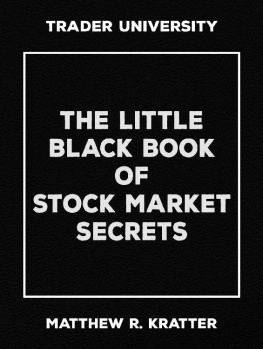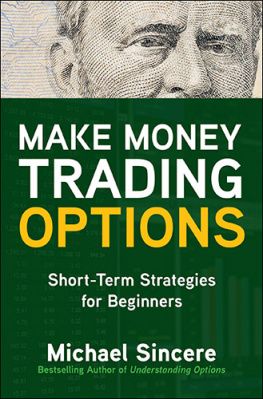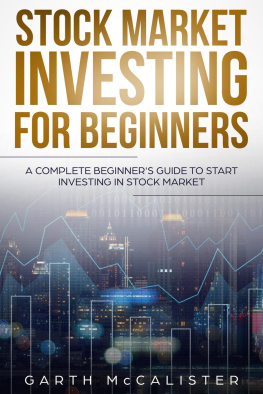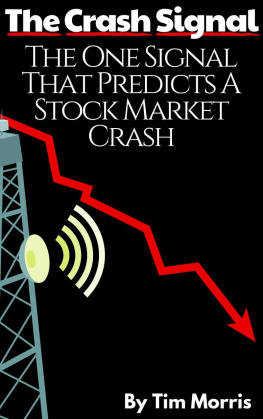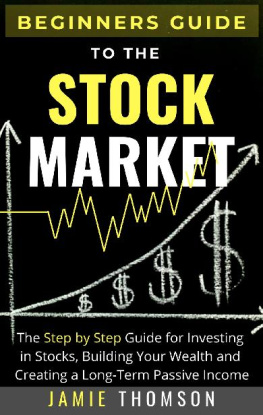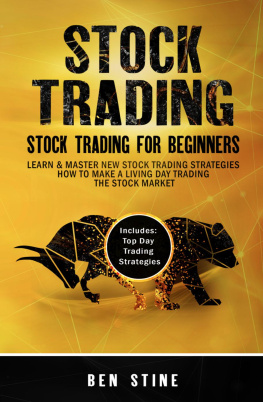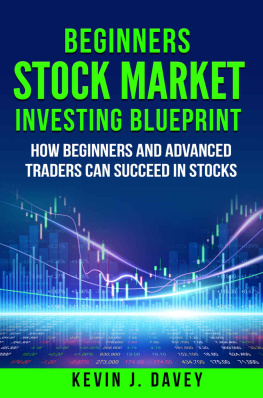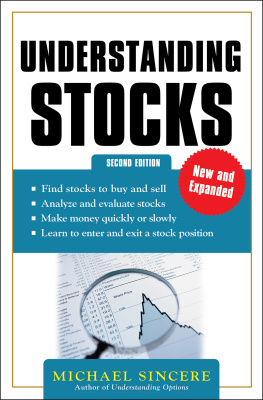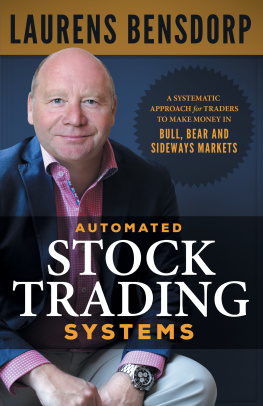Matthew R. Kratter
All rights reserved.
No part of this book may be reproduced in any form without written permission from the author ( matt@trader.university ).
Reviewers may quote brief passages in reviews.
Disclaimer
Neither Little Cash Machines LLC, nor any of its directors, officers, shareholders, personnel, representatives, agents, or independent contractors (collectively, the Operator Parties) are licensed financial advisers, registered investment advisers, or registered broker-dealers. None of the Operator Parties are providing investment, financial, legal, or tax advice, and nothing in this book or at https://www.trader.university/ (henceforth, the Site) should be construed as such by you. This book and the Site should be used as educational tools only and are not replacements for professional investment advice.
The full disclaimer may be found at the end of this book.
Your Free Gift
Thanks for purchasing my book!
As a way of showing my appreciation, Ive created a FREE BONUS CHAPTER that includes even more trading strategies and market wisdom.
In this Bonus Chapter, you will learn:
- The single most important factor that drives the markets in the short term
- How to profit from the stock markets seasonality
- What happens to the stock market when all experts agree
- How to pick the best stock in a given industry
- And much, much more
Tap the link below, and I will email you a free copy of this Bonus Chapter:
>>>Tap Here to Get Your Free Bonus Chapter<<<
Or simply go to
https://www.trader.university/secrets
Anyone Can Learn How to Trade
T he book that you are holding in your hands is a veritable gold mine of trading secrets and strategies. Its exactly the book that I wish Id had when I was first learning how to trade.
Ive been trading for over 20 years now, and during that time, Ive had the opportunity to make every mistake in the book, as well as the blessing to have had many big winners.
When you hear someone say The stock market is rigged or Trading stocks is too risky, you can be sure that you are in the presence of someone who has not put in the time and effort necessary to learn how the stock market really works.
You, on the other hand, are clearly different. You are destined for something greater. You purchased this book because something in the title, cover, or book description resonated with you. You know that trading is a skill that can be learned. And you are ready to put in the hard work to make it happen.
The market is not your friend, but it is also not your enemy. It is more like the waves on the ocean, or the heat from a fire-- just waiting to be harnessed by the savvy mind.
The stock market is the biggest opportunity machine ever created.
Read this book slowly, and let its lessons sink in. Read it again after youve had your first big losing trade. And read it whenever youre just looking for a little inspiration.
The Two Kinds of Markets, and How to Trade Them
T here are only 2 kinds of markets: trending and sideways. Knowing which kind of market you are in can be the difference between trading success and failure.
A trending market is one that keeps moving in the same direction (whether up or down) for an extended period of time.
Uptrends
Strong uptrends often start with a burst of momentum, like a rocket blasting off. This initial burst of momentum can be a gap-up in prices (usually on higher than average volume), or even a long bullish candlestick.
In an uptrend, you should try to buy high and sell higher. Buy when a stock closes above the top Bollinger Band (try using a period=80), and then exit when it closes below the middle Bollinger Band.
In a strong uptrend, oscillators (like RSI or Stochastics) will stay overbought for an extended period of time. If you try to short a stock because it is overbought, you will lose money.
If a company continues to report strong revenues or earnings growth and the overall market is in an uptrend, you should be very wary about shorting a stock, especially if it continues to hit new 52-week highs. Many a brokerage account has been blown up by doing this. Definitely dont try to short a stock if it gaps up to new highs after reporting good news.
Every stock that goes up a lot hits many new 52-week highs and all-time highs along the way. If the trend is strong, do not be afraid to buy a stock at an all-time new high, especially if it is trading higher on greater than daily average volume.
Always trade in the direction of the trend. In a strong daily uptrend, buy pullbacks on a 30-minute chart, or buy strong breakouts in the direction of the trend. In a strong uptrend, a stock will trade above its 50-day moving average most of the time, and its 50-day moving average will trade above its 200-day moving average.
The first warning sign occurs when a stock drops below its 50-day moving average. The second warning sign occurs when the stock drops below its 200-day moving average, or its 50-day moving average crosses below its 200-day moving average (the Death Cross). Most stock crashes happen after these 2 warning signs, so you will usually have no excuse if you are still in a stock that crashes.
Downtrends
Strong downtrends often start with a burst of downward momentum, like a rocket crashing into the earth. This initial burst of momentum can be a gap-down in prices (usually on higher than average volume), or even a long bearish candlestick.
In a downtrend, you should try to sell low (sell short) and buy back (buy to cover) lower. Go short when a stock closes below the lower Bollinger Band (period=80), and then cover your short when it closes back above the middle Bollinger Band.
In a strong downtrend, oscillators (like RSI or Stochastics) will stay oversold for an extended period of time. If you try to buy a down-trending stock because it is oversold, you will lose money.
If a company has been reporting bad news and the overall market is in a downtrend, you should be very wary about buying its stock, especially if it continues to hit new 52-week lows. Be especially wary if the stock gaps down after reporting bad earnings or bad news.
Always trade in the direction of the trend. In a strong daily downtrend, short rallies on a 30-minute chart, or sell strong breakdowns in the direction of the trend.
In a strong downtrend, a stock will trade below its 50-day moving average most of the time, and its 50-day moving average will trade below its 200-day moving average.
The first sign that a stock is bottoming occurs when the stock trades above its 50-day moving average. The second sign occurs when the stock trades above its 200-day moving average, or its 50-day moving average crosses above its 200-day moving average (the Golden Cross). Most large rallies happen after these 2 signals, which will give you plenty of time to buy the stock at the start of its new uptrend.
* * *
T he trend is your friend. Always trade in the direction of the trend, whether you are trading a 30-minute chart, a daily chart, or a weekly chart.
The trend is not your friend when it is about to end. If a trend has being going on for a long time and is being widely covered in the media, stay away.

